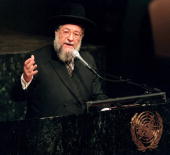Yisrael Meir Lau
He became a poster child for miraculous survival, and the inhumanity of the Nazi regime, after U.S. Army chaplain Rabbi Herschel Schacter detected him hiding behind a heap of corpses when the camp was liberated.[2][3] Lau has credited a teen prisoner with protecting him in the camp (later determined by historian Kenneth Waltzer to be Fedor Mikhailichenko).In 1988, after the death of his father-in-law, Lau was appointed to serve as chief rabbi of Tel Aviv, a position he held until 1993.Lau's spokespeople said that the fact that he had been approved by the (presumably heterogeneous) Prize Committee spoke for itself.3 In 1993, Rav Lau had an hour-long meeting with John Paul II at the Pope's summer residence of Castel Gandolfo, seeking the Vatican's moral support for the latest peace moves in the Middle East.Some critics in the Israeli media wrote that Lau was more focused on maintaining his image as a progressive than in implementing such positions in the rabbinate's policies, specifically major issues such as agunot, civil marriage, the status of Shabbat, and other divisive topics that continue to be relevant to many in the secular community vis-a-vis the Chief Rabbinate, which under Lau's leadership usually sided with the Orthodox perspective.[15] On 14 April 2011, he was awarded the Legion of Honor (France's highest accolade) by French President Nicolas Sarkozy, in recognition of his efforts to promote interfaith dialogue.So a few weeks later in January 1942, near Berlin in Wannsee, a convention can be held with a decision, a final solution to the Jewish problem.

the United Nations .
Chief RabbiTel AvivYad VashemPiotrków TrybunalskiIsraeliDavid LauJudaismHaredi JudaismAshkenazi Chief Rabbi of IsraelHebrewHolocaust survivorAshkenaziChief Rabbi of IsraelIsraelBuchenwaldPolishTreblinka extermination campNaphtali Lau-LavieU.S. ArmyHerschel SchacterKenneth WaltzerFedor MikhailichenkoMandatory PalestineyeshivaKol TorahShlomo Zalman AuerbachPonevezh YeshivaKnesses ChizkiyahuNetanyaoratorModi'inBinyamin (Benny) LauReligious ZionistStorahtellingTommy LapidUnited NationsMo'etzet of the Israeli Chief RabbinateLubavitcherMenachem M. SchneersonHarediModern Orthodox JudaismSephardicAshkenazicIsrael PrizeMasortiReformJohn Paul IIsummer residence of Castel GandolfoBenedict XVIagunotLegion of HonorNicolas SarkozyJerusalemBabi YarHolocaustHitlerWannseeUkraineWannsee ConferenceMesorah PublicationsList of Israel Prize recipientsMishpachaThe New York TimesAssociated PressFeldheim PublishersThe Jerusalem PostLos Angeles TimesJerusalem PostHa'aretzWayback MachineYizkor BookJewish titlesAvraham ShapiraYona MetzgerChief Rabbinate of IsraelOld YishuvMoshe ben Yonatan GalanteMoshe ibn HabibIsrael Yaakov AlgaziRaphael Meyuchas ben ShmuelYom Tov AlgazyMoshe Yosef Mordechai MeyuchasYom Tov DanonHakham BashiChaim Abraham GaginYitzhak KovoChaim David HazanAvraham AshkenaziRaphael Meir PanigelYaakov Shaul ElyasharYaakov MeirEliyahu Moshe PanigelNew YishuvAbraham Isaac KookYitzhak HaLevi HerzogSephardiBen-Zion Meir Hai UzielChief Rabbis of IsraelIsser Yehuda UntermanShlomo GorenKalman BerYitzhak NissimOvadia YosefMordechai EliyahuEliyahu Bakshi-DoronShlomo AmarYitzhak YosefDavid YosefShe'ar Yashuv CohenAryeh SternYaakov ShapiraYitzchak Dovid GrossmanYaakov RojaShimon ElituvAvraham YosefRatzon ArusiShmuel EliyahuYitzhak Peretz